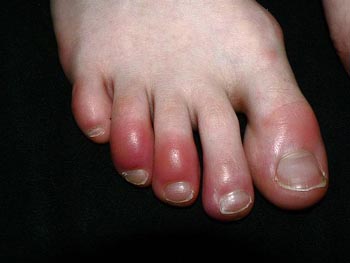Watch out, people who are coming to Australia with cold hands/feet! These scared me a little bit, wondering what the heck was going on with my toes. At first I thought it was carpet-mites or something, since we hadn't been vacuuming. But it's wasn't. I guess I revealed the non-cleanliness for no reason. Two more papers to go!
Too bad I didn't take a picture of my toes when I first had chilblains, they're a lot better now. I've been wearing socks, as strongly suggested by the doctor. Don't like wearing socks at home -.- I'll probably go get some cute pair of furry house slippers soon. For those whom I have told about my toes and those who, err, want to know more, here's some information.
**********
Chilblains are itchy and/or tender red or purple bumps that occur as a reaction to cold. The condition is also known as perniosis, and is a localized form of vasculitis - a form of disease that feature inflammation of the blood vessels. Children and the elderly are most often affected. In children, recurrences each winter for a few years are common but complete recovery is usual. Right; hear that, children?
Chilblains are due to blood vessel shut-down in cold conditions. They occur several hours after exposure to cold temperature. They are sometimes aggravated by sun exposure. Cold causes constriction of the small arteries and veins in the skin and rewarming results in leakage of blood into the tissues and swelling of the skin. Those with poor peripheral circulation are more likely to develop chilblains - i.e. blue-red mottled skin on the limbs.
Common sites for chilblains are:
- Backs and sides of the fingers and toes (this was me)
- Heels
- Lower legs
- Wrists of babies
- Over fatty lumps
- Nose (this would be unsightly)
- Ears
Each chilblain comes up over a few hours as an itchy red swelling and subsides over the next 7 - 14 days. In severe cases, blistering, pustules, scabs and ulceration can occur. Occasionally, the lesions may be ring-shaped and may become thickened and persist for months. Thank God this wasn't me.
Unfortunately, chilblains respond poorly to treatment.
To prevent chilblains, the hands and feet must not be allowed to get cold. Do not smoke! Nicotine constricts blood vessels. The following measures may help to keep you warm:
- Insulated and heated home and workplace
- Warm clothing, especially gloves, thick woolen socks and comfortable protective footwear. Keep the head and neck warm with hat and scarf. Have layered clothing on your body.
- Avoid substances that might constrict blood vessels; these include caffeine, decongestants and diet aids
- Before going outside, soak hands in warm water for several minutes to warm, then dry thoroughly
- Exercise vigorously before going outside
Study hard, everyone. Germany lost :(



2 comments:
wah chris!!! i super scared okay!!!! :( when i am in aus i would need someone to remind me often to layer up! dang boyfriends are convenient!
haha don't worry, i can help remind you :P bring woolen socks, and nice jackets okay.
Post a Comment